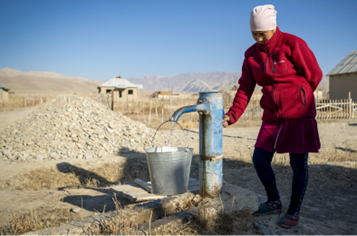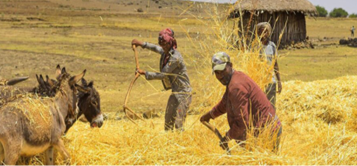Building A Resilient Future: How WFP’s Inclusive Risk Financing Work Is Strengthening Resilience By Advancing Financial Inclusion For The Most Vulnerable
- nwatters
- Sep 10
- 7 min read
Author: Andrea Camargo, World Food Programme (WFP).
On March 12th, e-MFP was pleased to launch the European Microfinance Award (EMA) 2025 on ‘Building Resilience through Inclusive Insurance’. This is the 16th edition of the Award, which was launched in 2005 by the Luxembourg Ministry of Foreign and European Affairs, Defence, Development Cooperation and Foreign Trade, and which is jointly organised by the Ministry, e-MFP, and the Inclusive Finance Network Luxembourg, in cooperation with the European Investment Bank. This year, e-MFP is also delighted to welcome as a strategic partner our friends at Microinsurance Network (MiN).
In this 7th piece in a series of blogs that we’ll be running throughout the year on this topic, Andrea Camargo from the UN World Food Programme (WFP) explains why closing the crisis protection gap requires a full range of tools to building resilience, including cash transfers, livelihood development, and of course an integrated approach to inclusive insurance.
In 2024, 343 million people faced acute hunger – 1.9 million of them in catastrophic conditions. With conflicts, climate extremes, and economic shocks on the rise, these numbers are likely to grow unless we adopt urgent actions, such as closing the crisis protection gap. Without financial tools – including insurance – families are left vulnerable, unable to rebuild when disaster strikes. Inclusive risk financing instruments that are accessible, affordable, and tailored to the needs of underserved populations, can be critical to close this protection gap.
Protecting Food Security and Strengthening Resilience Through Financial Inclusion
In today’s world of cascading crises, building resilience isn’t optional – it’s essential. WFP, the world’s largest humanitarian organization, is addressing this challenge not only through food assistance but by empowering people to better withstand and recover from shocks – and central to this effort is a focus on financial inclusion, as a way to enhance livelihoods and empower millions of people, leveraging its food security programmes through:
Interventions unlocking access to inclusive financial services through humanitarian cash transfers or government-to-person payments (G2P): WFP is increasingly transferring funds directly into individuals’ digital financial accounts, connecting people to formal financial services, often for the first time, and advancing their digital financial inclusion. As the world’s largest provider of humanitarian cash transfers – disbursing US$2.2 billion to 47 million people across 75 countries in 2024 alone - WFP has significant potential to drive transformative change. By 2030, WFP aims to support 10 million women and their families through their own financial accounts.
Interventions unlocking access to inclusive financial services through livelihoods and resilience programmes (non-cash transfer specific): WFP promotes access to financial services such as credit, savings, and insurance as part of broader programmes promoting resilience and livelihoods, such as:
* Smallholder Agricultural Market Support (SAMS) programme, which is WFP’s value chain development approach aiming at improving the livelihoods of smallholder farmers, promoting local value chain development and strengthening the resilience of local food systems;
* Inclusive Risk Financing (IRF) work, previously known as the R4 Rural Resilience Initiative (R4);
* The Youth in Work (YIW) programme, which aims to strengthen youth and women’s jobs food systems to promote increased value chain employment opportunities for young people in vulnerable communities;
* The SheCan intervention, which aims to improve economic and income-generating opportunities for women and their communities by supporting their access to affordable micro-loans tailored to their needs and enhancing their financial capabilities through gender-sensitive financial education programmes.
Inclusive Risk Financing
On Inclusive Risk Financing, over the past decade WFP has established itself as a global leader, reaching more than 10 million people with access to insurance, savings and credit to manage climate risks. This effort began with the R4 Rural Resilience Initiative and has since evolved into a comprehensive IRF approach. This shift marks a move towards a more integrated strategy, drawing on past learnings to strengthen the sustainability and resilience of food systems in the face of increasing weather and economic shocks.
In 2024 alone, over three million people in 16 countries were covered by WFP-supported inclusive insurance programmes, with more than US$248 million in financial protection[1]. When weather-related shocks struck, US$41 million in insurance payouts provided timely support to 1.5 million people—demonstrating the power of insurance to protect lives and livelihoods when it matters most. In addition to insurance, 320,000 people engaged in savings and loans activities, with 68 percent of them being women. Together, they saved a total of US$17 million and accessed loans worth US$10.2 million, reinforcing the role of integrated financial services in building long-term resilience and economic empowerment—especially for women.
More Than a Safety Net: Insurance Builds Long-Term Resilience
These financial tools don’t just offer a safety net—they build a foundation for long-term resilience. For instance, a 2023 study of WFP’s R4 Rural Resilience Initiative in Ethiopia, Kenya, Malawi, Senegal, and Zimbabwe carried out by TetraTech found that insured households were better equipped to cope during weather-related shocks. They were less likely to reduce food intake and more likely to recover quickly, invest in improved farming practices, and report higher food security.
Insurance can foster resilience and restore confidence. In the highlands of Kyrgyz Republic, livestock herder Aijan Talantbek saw her hay harvest plummet due to shifting seasons. In 2023, a severe drought left pastures barren and reduced fodder supplies, leaving her and many pastoralist families with few resources to sustain their livestock through the harsh winter. Thanks to WFP’s climate risk insurance that empowers local governments to provide support to vulnerable pastoralists, nearly 800 families received over 26 metric tons of barley when the drought triggered an insurance payout. This in-kind assistance was vital in bridging the fodder gap and ensuring the survival of their animals during the winter months. "Insurance is good," Aijan said. “We would have spent money on barley, but instead, the programme triggered payouts that we received through barley distribution - which really helped.”
WFP is now transitioning this programme in Kyrgyz Republic to a forecast-based model, releasing payouts before disasters strike. By promoting earlier action and increasing local government involvement, WFP is helping communities respond faster while supporting long-term sustainability.

Scaling Resilience Through Integration
Success lies not in standalone solutions, but in smart integration. WFP integrates insurance with complementary services—like savings, access to credit, financial education, improved agricultural practices and market access. This comprehensive approach enhances financial resilience and encourages broader adoption.
In Guatemala, savings groups have played a vital role in raising awareness about insurance and improving the ability to pay for it. In just three years, the number of people contributing to insurance premiums rose from 1,600 to over 9,000, while average contributions more than doubled. These groups not only build trust and financial literacy around insurance, but also help participants save and grow their incomes – enhancing their capacity to afford and sustain such services.
In Senegal, WFP worked with economic interest groups, including community-based cooperatives, often led by women. These groups distributed insurance, offered savings and loan options, and supported income-generating activities. As a result, the number of households paying insurance premiums with their own funds grew from 1,500 to nearly 28,000 in four years, accounting for 54 percent of all policyholders – a strong indicator of increasing trust, financial ownership, and sustainability.
Insurance Alone Isn’t Enough To Manage Weather Extremes
While insurance can be a vital lifeline, it must be part of a broader toolkit of risk management instruments. Different financial tools help manage different types of risk[2] and can reinforce resilience when brough together.
Ana Paula Sequeles, a 44-year-old mother of five in Tete Province, Mozambique experienced this firsthand. After the El Niño-induced drought in 2024 destroyed her crops, Ana received an insurance payout of about US$25 that enabled her to buy seeds for the next planting season. Ana was also part of a WFP-supported savings and loans group, which helped her build emergency reserves and manage her money wisely. That savings cushion allowed her to buy food for her children and keep her small business afloat during a critical time. “Without this payout, we would have nothing to hope for, so we are very thankful,” Ana says.

Sustainability Through Strategic Partnerships and Integration With National Systems
As weather extremes continue to threaten food systems and livelihoods, solutions like inclusive insurance must be scaled and sustained. But this will only work if they’re embedded within a larger ecosystem of financial services, risk management strategies, and government support.
To truly make a lasting impact, insurance schemes must be designed for long-term viability. That means involving committed stakeholders, building strong public-private partnerships (PPPs), and ensuring clear strategies for eventually handing over ownership to local institutions. One key success factor is integrating inclusive insurance into existing national systems that promote resilience, productivity, or social protection.
In Ethiopia, WFP jointly with Pula, took a market systems approach, fostering PPPs to boost both supply and demand for agricultural insurance. WFP supported the integration of insurance into the Government’s Input Voucher System (IVS). This move helped scale the programme from 20,000 farming households in 2022 to nearly 250,000 in 2024. By linking insurance to something farmers already value—input access—the programme tapped into real demand and ensured greater buy-in.
For farmers like Yohannes Negash in Ethiopia’s Amhara region, this shift has been life-changing. After enduring years of drought, locust infestations, and conflict, Yohannes enrolled in the insurance programme backed by WFP, the Ethiopian government, and local and international partners. “This insurance is a necessity,” said Yohannes. “Just as we have health insurance for our bodies, we need crop insurance for our farms.”
With US$675,000 in payouts delivered across the region, farmers like Yohannes are no longer just surviving—they're planning ahead and investing in a more secure future.

A Path Forward: Resilience Through Inclusion
WFP’s approach to inclusive risk financing goes beyond responding to crises—it empowers people to prepare for the unexpected, adapt to changing realities, and invest confidently in their futures.
By combining insurance with savings, loans, financial education, and integration into broader services, WFP is advancing financial inclusion as a powerful driver of resilience—transforming humanitarian assistance into a foundation for long-term stability, empowerment, and dignity.
In a world of increasing uncertainty, inclusive financial tools are no longer optional—they are essential for all. And WFP is making sure no one is left behind.
________
[2] For instance, insurance is a critical tool to manage severe and less frequent risks, whereas savings can be instrumental to build reserves enabling risk retention of more frequent and less severe risks.
About the Author:

Andrea Camargo is currently leading the Inclusive Risk Financing Portfolio at the World Food Programme (WFP). Born in Colombia, she is a qualified lawyer specialized in Insurance and International Law. Andrea has more than 20 years of experience in the insurance sector and 15 years of experience in the inclusive insurance and climate risk sector in more than 30 countries in Latin America, Europe, Africa and Asia. She has supported international organizations, development agencies, governments, private sector entities, among others, proposing pioneering solutions that are legally viable, financially sustainable and above all offer adequate protection against risks to those who need it most.





@basketball legends WFP’s inclusive risk financing approach is truly inspiring. Empowering the most vulnerable with financial resilience creates hope in the face of crises. Just like in the basketball legends game, teamwork and strategy make a real difference here too. I hope these efforts continue to expand and strengthen.
V3 game Lottery seems to be growing fast among online players. I like how simple the login and result sections are. Really good for anyone who enjoys digital lottery games.